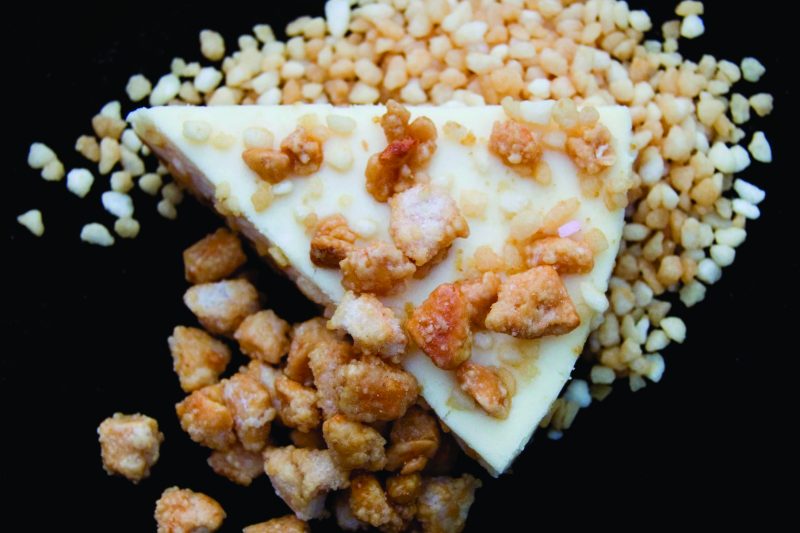Going nuts

Graham Kingston, commercial director of inclusions and toppings specialist Pecan Deluxe Candy (Europe), charts the progress of the inclusions market.
There is a growing national and international focus on healthy eating and the market for nutritious snacks and confectionery is undoubtedly on the increase. The value of the world snack foods market is expected to reach almost $335bn by 2015, while the UK market alone is expected to grow from more than £2.5bn (€3bn) to £3.8bn (€4.5bn) by 2016. So what are the key drivers behind a market that, just a few years ago, was in the doldrums?
For health and other reasons, nut inclusions will continue to have a key role in the ongoing renaissance of the UK snacking and confectionery sector. Nuts are a great source of healthy fats, protein, fibre, vitamins, minerals and antioxidants. They are also associated with reduced obesity and positive health benefits such as protection from heart disease and other conditions.
Health benefits
Since the misguided and generalist fear of fat as a dietary threat has evolved into much better informed nutritional knowledge, nuts in all their forms are gaining in popularity. It is now a well-known fact that nuts, in moderation, provide abundant health benefits, containing essential fatty acids or ‘good fats’, dietary fibre, phytochemicals and vitamin E. They are also an excellent source of protein and important minerals such as calcium, iron and zinc.
Throughout history, nuts have been part of the human diet across the globe. Records of eating pistachios date back to the Stone Age, about 7000BC, and early descriptions of diets and food intake indicate that the Romans, Persians and Arabs all used ground nuts to thicken stews and sauces, with that practice later extending to Europe. During exploration of Asia, nuts made their way from Persia to China and became a highly prized delicacy. Then, in Scandinavian countries, nuts were dried and stored to rely on throughout the long, harsh winters.
Now, increased consumer interest in weight loss and healthy eating, in conjunction with the inevitable evolution of eating patterns, is persuading the snack manufacturing industry to rethink its production processes and to consider the development of new offerings that will meet consumer demand for healthier snacks to better fit into a time-poor lifestyle.
The market
The fat content and health criteria of snack food products are not always important issues for consumers. By their very nature, many snack foods are considered to be an indulgence. Health and wellness themes, all-natural ingredients and new taste sensations continue to influence market share, but in the recession they failed to make a huge impact on the market as a whole. Nevertheless, for time-pressed consumers who lead hectic lives and eat on the run, snack foods have become a more than occasional convenient meal replacement or supplement. This, despite the traditional competition from confectionery products such as chocolate bars and candy, perceived generally as treats – or perhaps essential mid-afternoon fuel by some!
Still, hand-held products such as snack crackers, cookies, granola bars and other ready-to-eat items now compete effectively with savoury snacks for a share of the consumer’s budget. And the key to the growing success of these products? Nuts.
Going nuts
Nuts are the ideal inclusion for snacks and confectionery, bringing texture, taste and health benefits. Snack bars have emerged as an important alternative to traditional sweet snacks, such as chocolate, cakes and biscuits, while in the bagged snacks market, products based on rice or other cereals are making an impression as a healthier alternative to high-fat crisps and extruded snacks.
Nuts also feature in almost one-third of global chocolate confectionery products, with an even greater proportion of recent new product launches containing nuts.
Hazelnuts and almonds are the most popular inclusions and the chocolate sector accounts for about 31 per cent of all product launches featuring almonds every year. The attraction for consumers is improved mouth feel (crunchy texture), taste and perceived health benefits.
Over recent years, nut inclusions have almost completely reinvented their role within the worldwide market. Firstly they made their way into tub, food service and stick ice cream in multiple applications; then there was no stopping an insurgence into tray bakes, bakery and patisserie, whether artisan, in-store or high street. Finally delicious desserts, confectionery and cereal bar snacks succumbed to the lure of nut inclusions. These are supplied in the perfect format for their respective markets, whether it is frozen or ambient, bagged or loose product, processed or not – and in whatever quantities are required.
Just ignore the statistics for a moment and look at a typical supermarket shelf; about one-third of snacks and confectionery contains nuts of some description, whether almond flakes or walnut halves or pecan pieces. There is no denying the renaissance of nut inclusions across almost all sectors of food manufacture, but are some nuts better for us than others?
The benefits
In fact, all nuts are about equal in terms of calories per ounce and all are relatively healthy additions to any diet, although some offer better nutritional qualities. Almonds, for example, provide a slightly higher proportion of protein by weight than other nuts. However, they’re all essentially ‘good’ nuts. As long as you’re practising proper portion control and not downing handfuls at a time, any kind of nut will give you a good dose of healthy fats and nutrients.
Nuts have also been shown to help weight loss according to a report published in the American Journal of Clinical Nutrition. A review of 31 nut-related studies from across the world found that people who added nuts to their diets and who replaced other foods with nuts lost more weight (1.4 pounds more on average) and reduced their waist sizes by more than half an inch. It is not clear whether this is down to nuts helping to suppress hunger or feeling fuller for longer; either way, nuts in moderation have much to offer.
As for the positive health benefits, all nuts contain heart-healthy omega-3 fats, but walnuts also have high amounts of alpha linoleic acid (ALA), which research has suggested may help heart arrhythmias. A 2006 Spanish study suggested that they were as effective as olive oil at reducing inflammation and oxidation in the arteries after eating a fatty meal.
Aside from a strong foot-hold in the snacks and confectionery sector, some nuts are now being used in entirely different formulations such as flours, offering a gluten-free alternative to people with coeliac disease and those with sensitive digestive systems. Speaking of allergens, this is of course a key issue for any food manufacturer – effective segregation is not just a legal consideration but absolutely essential to protect consumers from a potentially life-threatening allergic reaction. Pecan Deluxe has made a significant investment in its segregated facilities to the extent that it can also offer Halal and Kosher ingredients – demonstrating its commitment to all markets including nut-free.
What’s next?
So, what next for the vibrant snacks market? Currently, there are a few key members of SNACMA (Snack, Nut and Crisp Manufacturers Association) including Kellogg, Kettle Foods, Walkers, United Biscuits and Intersnack who, together, account for 90 per cent of UK snack sales. Their success should come as no surprise since they have the multi-million-pound budgets to invest in new product development that results in new arrivals on already-crowded supermarket shelves on an almost daily basis. Only this week, I noticed that several well-loved biscuit brands have been transformed into snack bars; the innovation seems never-ending.
As for nut inclusions, again, it will be innovators who take the lead in a competitive market. In response to rising concerns about salt levels in all types of processed foods, Pecan Deluxe has recently introduced a reduced sodium pecan, which is as ideal for use in cereals and snack bars as it is in tray bakes, desserts and indulgent ice cream where pecans have for many years proved their worth. Neither would we ignore demand for traditional inclusions – for example a salty blend of nut inclusions – to cater for different palates across the UK and Europe.
There is no doubt that snacking is a growing market and will remain so, as will the focus on choosing healthier snacks. With after school snacking and the over-55s markets recently identified as offering significant untapped potential – and with both sectors likely to favour healthier options – nut inclusions are certain to play a key part in snack and confectionery products for many years to come. ♦



